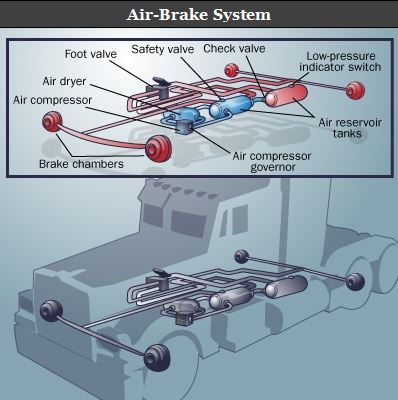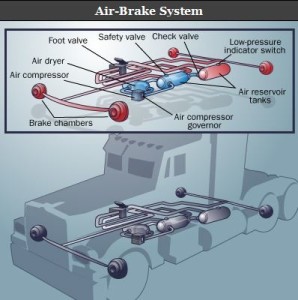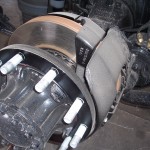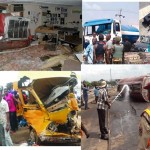
WHY BRAKES FAIL:
Brake Imbalance
A brake performance problem that probably account for most accidents involving brake failure is brake imbalance, which can be caused by deficiencies that affect some of the brakes in the system but not others. Brake imbalance can also happen by having mismatched brake system components that cause some brakes to work harder than others. Brake imbalances can lead to instability during braking, brake fade, and brake fires.
Good brake balance is a result of having properly matched, maintained, and adjusted brake system components, as well as a properly loaded trailer. There are two main types of brake balance; torque balance and pneumatic balance. Proper torque balance is created by having matched mechanical components (e.g. brake linings), which are working properly and adjusted correctly. If a truck has a torque imbalance, some of the brakes will work harder and lock up easier than others. When a truck has a torque imbalance problem, brakes are usually affected individually. Proper pneumatic balance is created by having equal air pressure at all wheel ends. When a truck has a pneumatic imbalance, some of the brakes will also work harder and lock up easier than others. However, pneumatic imbalance will be manifested at one axle or one set of tandem axles, such as the tractor drive axles or the trailer axles.
Brake imbalance is one of the more common causes of loss-of-control crashes for air-braked trucks. If a truck does not have good brake balance, it will have a propensity toward either jackknifing or trailer swing-out. Jackknifing occurs when the tractor’s drive axles achieve a higher level of braking force than the trailer axles. When this happens in an emergency or low traction situation, the tractor drive axles will likely lock up while the trailer axles are still rolling. With the tractor’s drive axles locked, they will lose directional stability and the unbraked trailer load will push the tractor into a rotation around the king pin. Trailer swing-out is similar to a jackknife, but occurs when the trailer axles achieve a higher level of braking force than the tractor. With the trailer brakes locked and directional stability lost, the tractor will drag the trailer, which will then begin to swing out.
As you can see, if the brake system is not balanced for any one of a number of reasons, the result will be that some of the brakes will have to work harder than others. This imbalance can cause the hardest working brakes to become too hot, resulting in brake fade or fire. This usually happens when the truck with a brake imbalance is descending a long steep grade. As a truck is being braked, the properly working brakes will be doing more than their share of the work. This will cause the overworked brakes to become much hotter than they should be and may eventually lead to brake fade. When the good brakes fade, the only brakes available to stop the truck will be the deficient ones. Additionally, as the brakes get hotter, they can catch on fire and/or catch the corresponding tyres on fire. A brake imbalance will also affect the stopping distance. Because the deficient brakes will not be working at their peak efficiency during hard brake applications, the truck will take longer to stop.
Brake Maintenance Deficiency
Air brake maintenance offers safety and minimizes the occurrence of accidents. Brake systems offer minimal braking force even with maintenance deficiencies. Negligence or the lack of proper vehicle maintenance by highly skilled mechanics results in a longer braking period, which can cause collisions. Some of the common problems affecting air brakes due to improper maintenance include improperly attached hydraulic lines. The brakes may also overheat and damage the brake pads or rotors. A vehicle may also lack the brake shift interlock system, which prevents the driver from diverting out of a parking lot without having to depress the brake pedal.
Improper Application of Stopping Distance (i.e. Drivers Behavioural deficiency or inexperience)
Driving too fast is a major cause of fatal crashes. Speed must be adjusted to the driving conditions. These include traction, curves, visibility, traffic, and hills. Speed affects stopping distance. Whenever you double your speed, you need about four times as much distance to stop. Your vehicle will have four times the destructive power if it crashes. By slowing down, it reduces braking distance. Normal brakes are affected by three factors; Perception Distance, Reaction Distance, and Braking Distance.
Perception Distance: This is the distance your vehicle travels from the time you see a hazard until it is recognized by your brain. The perception time for an alert driver is about 3/4 second. At 55 mph, you travel 60 feet in 3/4 second.
Reaction Distance: This is the distance traveled from the time your brain tells your foot to move from the accelerator until your foot actually pushes the brake pedal. The average driver has a reaction time of 3/4 second. This accounts for an additional 60 feet traveled at 55 mph.
Braking Distance: This is the distance it takes to stop once you apply the brakes. At 55 mph on dry pavement, a heavy vehicle with good brakes takes about 170 feet and 4 1/2 seconds to stop.
Air brakes have an added delay: the time required for the brakes to work after you push the brake pedal. With hydraulic brakes (used on cars and Iight/medium trucks), the brakes work instantly. With air brakes, it takes time (1/2 second or more) for the air to flow through the lines to the brakes. Thus, the total stopping distance for vehicles with air brake systems has four different factors:
Total Stopping Distance: Perception distance plus reaction distance plus braking distance equals the total stopping distance. At 55 mph, it takes about 6 seconds to stop. The total distance your vehicle will travel is about the length of a football field: 60+60+ 170= 290 feet.
The air brake lag distance at 55 mph on dry pavement adds about 32 feet. So at 55 mph, an average driver under good traction and brake conditions has a total stopping distance over 300 feet (longer than a football field).
EVERY RESPONSIBLE HAULAGE FIRM SHOULD HAMMER THIS INTO THE CONSCIOUSNESS OF THEIR DRIVERS CONTINUALLY!
Panic Driving Leading to Excessive Braking
When you use the brakes, shoes or pads rub against the brake drum or discs to slow the vehicle. Braking creates heat; but, brakes are designed to take a lot of heat. They can fade or fail from excessive heat caused by using them too much and not relying on the engine braking effect.
Brakes, tyres, springs, and shock absorbers on heavy vehicles work best when the vehicle is fully loaded. Empty trucks require greater stopping distances because an empty vehicle has less traction. The wheels of an empty vehicle tend to bounce and cause lockup of its wheels, thus creating poorer braking action.
Excessive use of service brakes results in overheating and leads to brake fade. Brake fade results from excessive heat causing chemical changes in the brake lining that reduces friction and causes expansion of the brake drums. As the overheated drums expand, the brake shoes and linings have to move farther to contact the drums and the force of this contact is reduced. Continued overuse may increase brake fade until the vehicle cannot be slowed or stopped.
Brake fade is affected by adjustment. To safely control a vehicle, each brake must do its share of the work. Brakes out of adjustment will stop doing their share before those that are correctly adjusted. The correctly adjusted brakes can overheat and fade leaving you insufficient braking available to control the vehicle. Brakes can get out of adjustment quickly, especially when they are hot.
Deficient Air Brake Pre-Trip Inspection
How often do you carry out pre-trip inspections on vehicles before operating them? Regular pre-trip inspection helps ensure that all the safety devices in a vehicle are operating properly. Where there is negligence in this area, the reverse is the case.
De-powering the front brakes
Some truck owners or drivers deliberately unhook or depower the front brakes on the truck and rely only upon the brakes of the trailer and downshifting to stop or slow the vehicle. They do this in order to minimize the expense of tire and brake wear and replacement costs. This is extremely lethal! The implication is that the combined effect of double braking system is being impaired by half and this could spell the difference between life and death or multiple casualties.
Improper loading
If the truck load is not evenly distributed, the brakes may overheat and malfunction.
Now that we know what could make brakes fail, the next question will be how do we guide against it? This we treat extensively below.
CLICK HERE to continue reading in Part Three.







